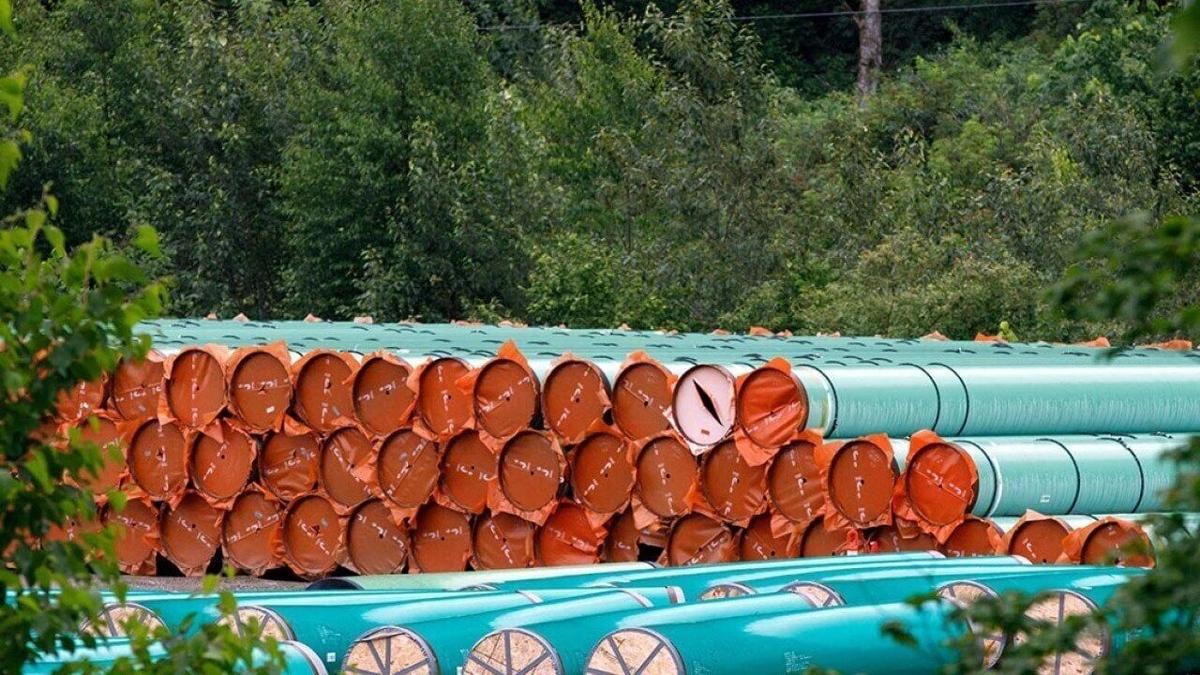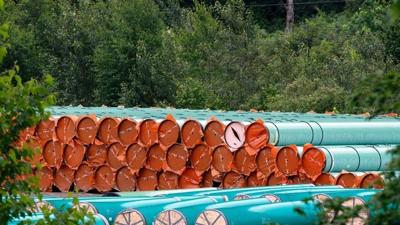![]()
āBuild, baby, buildā: A guide to Canadaās efforts to fast-track pipelines and mines
You may have noticed Canadians are in a bit of a mood ever since a and economic well-being. The impact has spread to the highest levels of government policy, reports.
The federal government, industry, and provinces are seizing the crisis to try and build more stuff more quickly ā ābuild, baby, buildā in the words of our prime minister ā under the premise that it will help reduce dependency on an increasingly unpredictable neighbour.
People are also reading…
Bill C-5, or the One Canadian Economy Act, aims to break down interprovincial barriers to trade and employment, but also to allow projects deemed by the government to be in the national interest to bypass certain regulations, in order to speed up construction. It passed the Senate, its last parliamentary hurdle, on June 26.
Itās been labelled a an , and a . Others say itās a and a to stimulate an economy that is being strangled by overly bureaucratic regulations.
So what is the One Canadian Economy Act? How has such a controversial bill been able to sail through the House of Commons and Senate on its way to being law? What exactly can it do (and not do)? And why should people care?
Hereās a breakdown of what to know.
So, okay, what is Bill C-5?
There are two parts . One deals with removing barriers to trade and employment between provinces, which really hasnāt provoked any controversy. Significant hurdles sometimes make it easier to sell to the U.S. than to a provincial neighbour, and the legislation tries to fix that.
Likewise, the bill aims to allow more freedom of movement for workers within the country.
Where the controversy starts is in the second part of the bill, the so-called Building Canada Act.
According to the bill, the purpose of the act is āto enhance Canadaās prosperity, national security, economic security, national defense, and national autonomy by ensuring that projects that are in the national interest are advanced through an accelerated process that enhances regulatory certainty and investor confidence, while protecting the environment and respecting the rights of Indigenous Peoples.ā
Sounds promising. But thereās more.
To sum up, without parroting the dense legalese of the bill, the act essentially says that if a project is determined to be in the national interest (definition TBD), then anything the project needs to do in order to be approved is considered to have been done.
Only then will the minister in charge outline the specific conditions that have to be met by the proponent of a project. The government can also bypass regulations and legislation to expedite the process.
That has raised concerns (more to come).
The act specifically says those national-interest projects should strengthen autonomy and security, provide economic āor otherā benefits, have a high likelihood of success, advance the interests of Indigenous Peoples, and ācontribute to clean growth and to meeting Canadaās objectives with respect to climate change.ā
Opposition parties did manage to include amendments before the bill passed the House of Commons and headed to the Senate, including a list of legislation projects cannot bypass, including the Indian Act, the Foreign Influence Transparency and Accountability Act, and the Criminal Code.
But it still leaves the door open to the government picking projects and then allowing them to skip over any number of other regulations, including those dealing with environmental impacts.
What kinds of projects could be fast-tracked under Bill C-5?
This bill could impact everything from mines and pipelines to electricity grids.
The focus is on economic corridors, getting goods to market, and developing natural resources and energy infrastructure.
A calls for a focus on projects that prioritize environmental improvement, including renewable energy projects, and avoiding projects that could result in stranded assets (including fossil fuel developments) or that do not have Indigenous support.
In reality, the legislation would give politicians, specifically the federal cabinet, the power to decide which projects should be fast-tracked.
Why is Canada doing this?
Given that the U.S. president has overtly threatened Canadaās economic and political security, it makes sense to consider some changes in the relationship, as Canadaās economy has long been deeply entwined with that of its neighbour.
But there are also pressures on the homefront, including seething intent on more sovereignty, or independence, for the home of Canadaās oil patch.
There is also frustration within the nebulous ābusiness community,ā or at least the natural resource sectors, with whatās perceived as overly stringent regulations and long timelines for building big projects.
The reality, however, can be more complicated. The federal government and its policies arenāt always what holds a project up, according to a recent .
That analysis showed delays are sometimes from the companies themselves, mulling whether to make an investment in the project or asking for extensions and not submitting required documentation.
All of those national and international pressures are coming as a new federal government settles into Ottawa under the direction of Prime Minister Mark Carney, whose experience comes from central banks and boardrooms ā and who is viewed as a CEO-style leader who wants to get things done.
Okay, but are regulations bad?
There is no doubt regulations on everything from emissions to wildlife to health and safety can add to the complexity and costs of a project. That can delay things.
Those regulations also ensure protection for wildlife, the environment, and human health. A outlines the lasting harms that can result from weak or poorly enforced regulations, and the risks of fast-tracking projects.
According to the report, examples include Imperial Oilās or mercury contamination from the Dryden Chemical plant in Ontario, which continues to impact the waters of the English-Wabigoon River system, Winnipeg River, and Lake Winnipeg.
One paradox of the current conversation is the argument that Canada should be trusted to build more and supply more energy because it has more stringent environmental, legal, and social practices than other countries, while also arguing the regulations that make it more ethical should be pared back.
All that said, it should be noted this legislation doesnāt completely disregard oversight. There are requirements for the government to publish details on the specific conditions attached to national interest projects and why certain requirements were waived.
Do provinces and Indigenous communities have a say in Bill C-5?
The Bloc QuĆ©bĆ©cois managed to insert an amendment to the bill that requires a province to provide written consent for a designated project if it falls āwithin areas of exclusive provincial jurisdiction,ā but that would not apply to every project.
A pipeline that crosses provincial borders, for example, falls under federal jurisdiction, but could cause tension between neighbouring provinces. Specifically, getting a pipeline from Alberta to coastal waters could be politically challenging.
Recently, Alberta Premier Danielle Smith has been suggesting an announcement on a new pipeline proposal could be , although there company or industry group that wants to build one.
The federal government also pledges to work directly with provinces and to consult with them when a project falls within their territory.
Politically, it would be counterproductive to ram through projects that upset a particular province ā when the argument for the act is to unite Canada in its fight with the U.S.
When it comes to Indigenous communities, the process is less clear and more fraught.
While the opposition parties did include the Indian Act as a piece of legislation that cannot be bypassed, the bill ignores the more stringent requirements of the United Nations Declaration on the Rights of Indigenous People.
The bill calls for consultation with affected Indigenous communities, but appears to avoid the need for āfree, prior and informed consent,ā as outlined in the United Nations declaration.
Many First Nations and Indigenous organizations are also upset with the , arguing they were not consulted ahead of time and feel betrayed. There has been widespread condemnation of the bill ā including from in Treaty 6 territory ā and vows of protest and disruption in response.
Any word on what Canadians think about Bill C-5?
Again, Canadians as a whole are in a mood. But shows thereās nuance in support for building big projects quickly.
While almost three-quarters of respondents said they support fast-tracking major projects, nearly half donāt want environmental reviews bypassed to do so. There is also a majority support for not allowing provinces to get in the way of a national interest decision.
What now?
Now that the Senate has passed the bill, the government will have to list projects it considers in the national interest that should be prioritized. Those projects would then be fast-tracked, but depending on how far advanced they are, it could still take months or years before shovels are in the ground.
In the case of a pipeline, as envisioned by Albertaās Smith, it would take years to develop.
Smith has also said sheās to move on a list of unilateral demands from her government, all geared at drastically increasing support for the oil and gas sector.
Some Indigenous organizations have , and there will be significant pushback from environmental groups, among others.
Thanks to an amendment before the bill passed the House of Commons, the clock will also start ticking on a review of the act and the actions of the federal government, the first of which is set to take place after 180 days.
The act will be reviewed by the government in five years to establish whether it is meeting its objectives ārelating to shared jurisdiction, public safety, national and international security, the quality of the environment, public health, transparency, public participation and the protection of the rights of Indigenous Peoples and linguistic communities.ā
In between it all, there will be lingering questions about whether the government is able to get projects moving while also balancing social, political, health, and environmental concerns.
Oh, and thereās still a trade war going on.
was produced by and reviewed and distributed by .



















